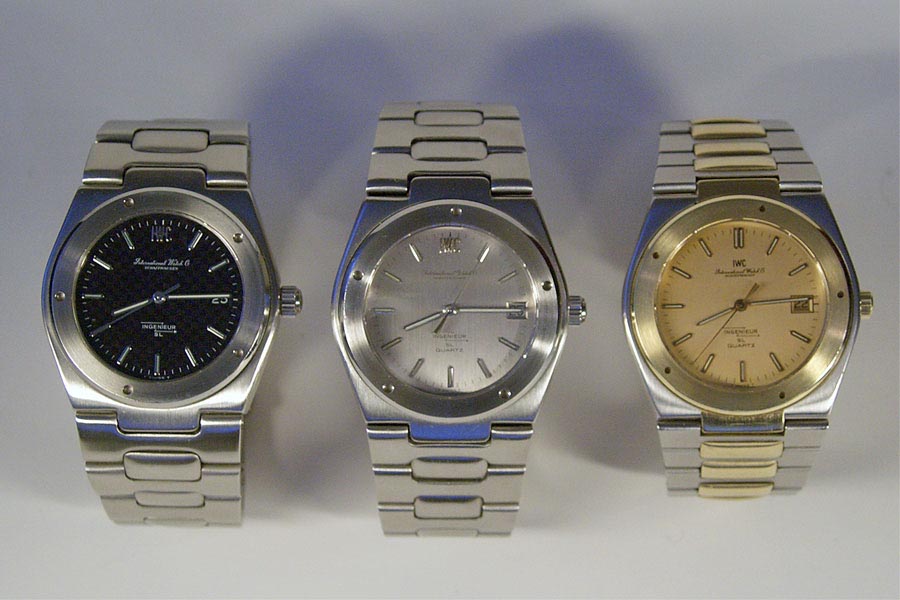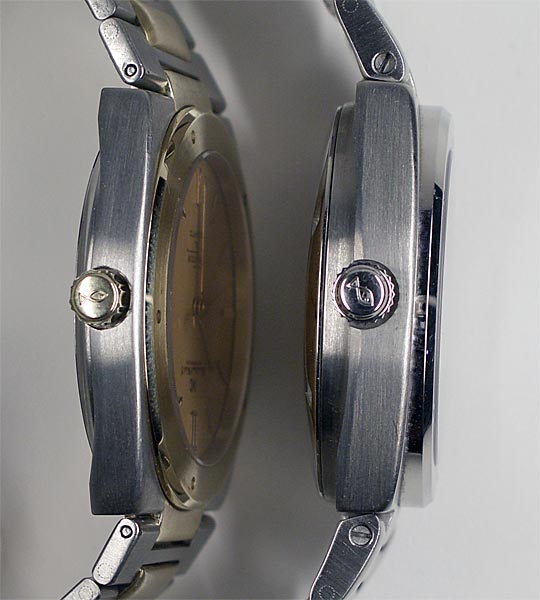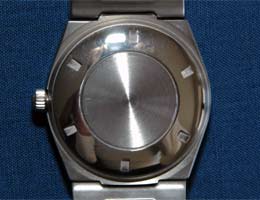
The ref. 1832 and her relatives with IWC automatic (cal. 8541ES) or quartz movement
 |
1976-1984: The «Jumbo» Ingenieur SL
The ref. 1832 and her relatives with IWC automatic (cal. 8541ES) or quartz movement |
deutsche Version |
| previous range | back to overview | next range |
IWC introduced the 3rd generation of its famous Ingenieur line at the height of the quartz crisis in 1976. The change meant a radical re- design of the whole line. While the new model inherited the concept of a sturdy professional watch from its ancestors, it translated it into the stylish language of the seventies. The result was a luxury and sporty dress watch which followed the path Audemars Piguet had successfully led a few years before with their Royal Oak. The similarities didn't come as a surprise. IWC had hired Gerald Genta for designer, the very man who had created the Royal Oak as well as Patek’s Nautilus (and who was going to design the VC 222). Apart from the Ingenieur SL, Genta conceived several other new models for IWC’s Collection SL, with the Ingenieur as clear leader model. Among them were the Polo and Golf Club models. Whether he was also responsible for the Yacht Club II, is disputed. Collection SL originally meant Steel Line, but was later normally interpreted as Sports line.
design of the whole line. While the new model inherited the concept of a sturdy professional watch from its ancestors, it translated it into the stylish language of the seventies. The result was a luxury and sporty dress watch which followed the path Audemars Piguet had successfully led a few years before with their Royal Oak. The similarities didn't come as a surprise. IWC had hired Gerald Genta for designer, the very man who had created the Royal Oak as well as Patek’s Nautilus (and who was going to design the VC 222). Apart from the Ingenieur SL, Genta conceived several other new models for IWC’s Collection SL, with the Ingenieur as clear leader model. Among them were the Polo and Golf Club models. Whether he was also responsible for the Yacht Club II, is disputed. Collection SL originally meant Steel Line, but was later normally interpreted as Sports line.
There were news on the movement side, too. Genta’s Ingenieur SL could still be had with the latest version or IWC’s acclaimed automatic calibre (8541ES), but in this age where the future seemed to belong to the quartz movement it was for the first time also offered with the bought-in quartz calibre 2405.
Despite its qualities the new Ingenieur was no commercial success. Reportedly, only 978 pieces were sold between 1976 and 1984, and even this number includes both quartz versions. This rather disappointing result was mostly due to the fact that the Ingenieur was launched at the wrong time. In 1976, sales of all models had almost stopped, and when interest in mechanical watches slowly revived in the late seventies, fashion had changed. The large and bulky Ingenieur was too big and too heavy for the taste of the time which favoured delicate and flat watches.
Genta’s design
 For the Ingenieur SL, Genta designed a cushion shaped case, with both the case back and the bezel screwed to it. The most conspicous detail are five recesses in the bezel. Those are ornamental as well as functional, for they serve as a purchase for the screwing tools and - being screwed to a coincidental position - should give each watch its individual touch. This feature didn't find universal acclaim, many potential buyers couldn't cope with the often resulting asymetric layout of the bezel.
For the Ingenieur SL, Genta designed a cushion shaped case, with both the case back and the bezel screwed to it. The most conspicous detail are five recesses in the bezel. Those are ornamental as well as functional, for they serve as a purchase for the screwing tools and - being screwed to a coincidental position - should give each watch its individual touch. This feature didn't find universal acclaim, many potential buyers couldn't cope with the often resulting asymetric layout of the bezel.
Originally, the same cases were used for both the quartz and automatic versions of the Ingenieurs. Actually, a few of them were later converted by IWC from quartz to automatic when the demand for mechanical movements proved to be higher than expected (still keeping their original reference numbers on inside of the case back). However, when the extra-flat quartz calibre 2250 replaced the calibre 2405, a new case with the same diameter, but reduced height was introduced for the quartz version.
In all instances, Genta’s Ingenieur SL was a large and heavy watch. With a diameter of around 30 mm the dial was of standard size, but the wide bezel, the cushion shaped case, and the more than just sturdy and rather rigid integrated bracelet all contributed to an overall size of 40x38mm and a hefty weight of almost 150 g. The center second hand, the Pellaton winding mechanism and the soft iron cage took also their toll, and so the SL was rather thick, too (just below 14mm). Compared to its archetype, the bulky SL gave the impression of sporty sturdity rather than of elegance, and thus soon earned its nicknames “Jumbo” or the “Fat” Ingenieur. But it had its own flair and gave the Ingenieur a distinctive new face which was to dominate the line to this day.
For further reading see J. M. Mehltretter, IWC Ingenieur SL Ref. 9232, Klassik Uhren 2000/1, p.51-56.
The «Ingenieur SL Automatic», nick named «Jumbo» or «fat» Ingenieur (ref. 1832)
The heart of the ref. 1832 remained IWC’s automatic calibre in its latest iteration. It also kept the well proven soft iron a cage as a protective shield against electro-magnetic fields. But the calibre 8541B was further enhanced to the calibre 8541ES whose designation means that it contained special amagnetic parts (E) and a – like its precursor – a stopp second mechanism (S). It was furthermore cushioned within the case with shock absorbers, a concept IWC already had used on the Yacht Club before.
The SL featured came with three different type of dials. Especially the black one with it's check pattern (guilloché) was a real attractive one. All in all, less than 600 pieces of the automatic model were produced.
Not much more needs to be said about the «Ingenieur SL Automatic». Affectionately called the «Jumbo Ingenieur», it enjoys the status of a cult watch. It's unusal and bulky design which obstructed its success in the seventies and early eighties and resulted in low production numbers now serves to its advantage. And then there is its calibre 8541ES which is generally regarded as the perfection in the long line of the famous IWC automatic movement. No wonder that the Ingenieur SL are generally sought-after, especially the steel ones. Accordingly prices were soaring during the last then years.
Specifications:

The first version of the Ingenieur SL Quartz (ref. 3003)
The first generation of quartz Jumbos came with ETA's 12 1/2 lignes calibre 2405. It used the same case as the automatic model, in fact some pieces were later converted by IWC on customers’ demand from quartz to automatic and vice versa. Some experts claim that the quartz Jumbo used different bracelets than the automatic but I found no evidence for that. It was only the second quartz version which featured a new style bracelet which served as a model for the future midsize Ingenieurs.
The quartz Jumbo was not present in the first SL catalogue and may have been introduced in 1977 only. The stainless steel and mixte models were listed until 1979. In 1980 they were replaced by the ref. 3303 whose new 11 1/2 calibre 2250 allowed for a substantial reduction in height (to 8mm). The steel version of the ref. 3003 came with the same rhodanized or black dials than their automatic siblings. Just the inscription “Quartz” has been added to the dial.
The given production number of 335 pieces represents the total of ref. 3003 produced and includes an unkown number of mixte models.
Specifications:
The second version of the Ingenieur SL Quartz (ref. 3303)
The 2nd generation of quartz Jumbos was first listed in 1980 when it replaced the first quartz Ingenieur (ref. 3003). The model was sold out by July 1985.
The new 11 1/2 calibre 2250 allowed for a substantial reduction in height (to 8 to 8.8 mm) and was also used in the quartz version of the later introduced midsized Ingenieur (nicknamed «Skinny»). Apart from the fact that its case was much flatter, it also had a new type of bracelet which was less rigid than the original one and served as prototype for most of the future Ingenieur models.
Specifications:
| previous range | back to overview | next range |